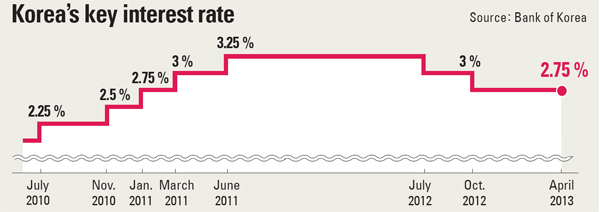In a surprise, central bank leaves rate unchanged

The central bank’s governor, Kim Choong-soo, had been widely seen as in step with the government, causing some to perceive an erosion of the bank’s autonomy.
At a press conference announcing the rate decision, Kim said that although slow growth is likely to continue, there is no need to further ease monetary policy.
“As we have noted earlier, the effects of the lowering of the rate in two accounts [last year from 3.25 percent] are starting to surface,” Kim said, adding there is too much liquidity in the market already.
Recently, the central government, which has made the economy a priority, has pressured the central bank to ease monetary policy. With a proposed 17 trillion won ($15.1 billion) supplementary budget, the government was hoping that a rate cut would further boost its efforts.
Hyun Oh-seok, finance minister and deputy prime minister of economy, earlier this week once again stressed the importance of a fiscal, monetary and real-estate policy mix.
Cho Won-dong, Blue House senior secretary on economic affairs, as well as Lee Hahn-koo, floor leader of the ruling Saneuri Party, also nudged the central bank as they emphasized the need for an economic boost.
This sparked an outrage from the central bank’s labor union, which declared that monetary policy decisions should be made independently.
There have also been rumors that some top officials in the Blue House are trying to elbow out the central bank governor a year before his four-year term ends.
Kim has headed the central bank since 2010, under the Lee Myung-bak administration.
The governor yesterday downplayed possible interference from the administration.
“The first and upmost role of the central bank is to serve the economy through stabilizing consumer prices,” Kim said, adding that the only factors considered when deciding monetary policy are how the decision will affect the economy in the midterm and how economic development can help the nation and its people.
“Pressure from outside [the central bank] to lower the rate did not play a significant role in the decision,” he said, while noting the importance of close policy coordination and cooperation with the central government.
“Although the timing in deciding on a policy may be different, [fiscal or monetary policy] is headed in the same direction,” the governor said. “In this sense, a policy mix is followed.”
Kim also stressed the central bank will not take the entire blame if the economy does not recover as expected even after additional government spending through the supplemental budget.
“I wouldn’t say the central bank is free of responsibility regarding its judgment,” Kim said. “However, monetary policy is not the absolute cure, and we need to compare the pros and cons.”
The central bank and the Ministry of Strategy and Finance also had different views of economic growth for this year. The central bank later in the day announced its revised outlook for this year’s growth, lowering January’s projection of 2.8 percent to 2.6 percent.
The Finance Ministry on March 28 cut its projection from 3 percent to 2.3 percent.
The central bank said the Finance Ministry has a more pessimistic outlook because it predicts a 12 trillion won shortfall in tax revenue this year, whereas the BOK assumes the supplemental budget will cover any shortfall.
However, Kim added that the revised outlook did not take the supplementary budget into account as it has not passed the National Assembly.
The central bank governor was confident the economy is improving at a pace that was expected. He said the revision to 2.6 percent was largely because third- and fourth-quarter growth last year turned out to be slower than forecast.
The central bank projected the economy will recover in the second half of the year. In the first six months, GDP will likely expand 1.8 percent year-on-year, while in the second half it would grow at 3.3 percent. For next year, the central bank projects 3.8 percent growth.
The bond market was thrown off guard as the market was betting on a rate cut. Yield on three-year Treasuries added 0.17 percentage point to 2.65 percent, the sharpest increase in more than two years.
The central bank, however, made a gesture in taking part of the government’s effort to prop up the economy as it raised the cap on soft loans to small companies, particularly start-ups with advanced technologies, from 9 trillion won to 12 trillion won. The interest rate on such loans was lowered from 1.25 percent to between 0.5 percent and 1.25 percent.
“The BOK is unpredictable, but the fact the central bank refrained from cutting rates suggests it is more independent than many believe,” said Matthew Circosta, a Moody’s Analytics economist. “An easing bias remains because the negative output gap allows the central bank to keep rates lower for longer.”
By Lee Ho-jeong [ojlee82@joongang.co.kr]










with the Korea JoongAng Daily
To write comments, please log in to one of the accounts.
Standards Board Policy (0/250자)